Once upon a time, an attempt on the life of a sitting president (or a former president) would have all but guaranteed re-election. We don’t live in that world anymore. Things got weird. And that’s potentially a good thing, depending on your politics. Chris Graham weighs in on some polling data that in another universe, would be almost inconceivable.
Another day, another assassination attempt on former US president Donald J. Trump.
Overnight, a 58-year-old man, Ryan Wesley Routh, was captured by police after he was allegedly spotted lying in wait for Trump while the ex-president was playing golf in West Palm Beach, Florida. A Secret Service agent reportedly began firing on Routh after spotting a rifle poking through a fence. Routh, who was about 500 metres from Trump when he was discovered, fled the scene but was apprehended by police a short time later.
It’s the second time in as many months someone has tried to kill Trump, although on this occasion, the gunman wasn’t able to fire off any rounds. That’s obviously in stark contrast to the incident on July 13 in Butler, Pennsylvania, when Trump’s ear was grazed by a bullet.
That shooting sparked widespread speculation across the political spectrum that having been wounded in an assassination attempt, Trump was now a shoe-in for the American presidency.
The facts, and the polling, tell a radically different story.
No bump for Trump
For most of 2024, Donald Trump led US president Joe Biden in the polls. It was never by more than a few points and by July 13 – the day Trump was scheduled to speak in Butler – the polling numbers remained tight, at 42.3% for Trump, and 40.3% for Biden.
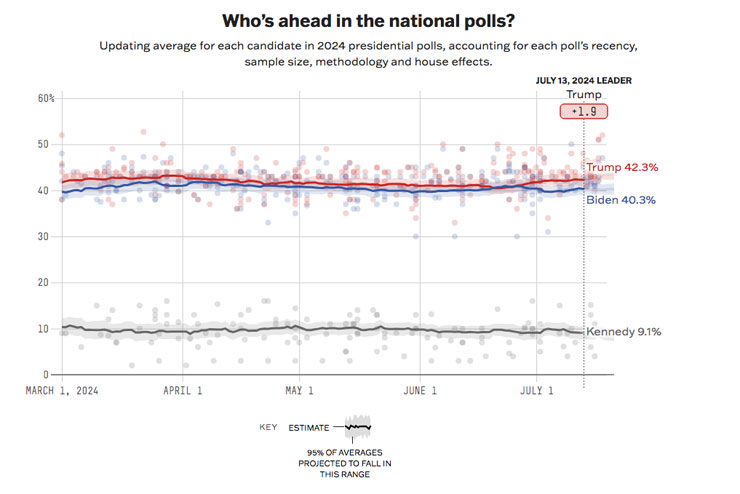
And then, Thomas Matthew Crooks, a 20-year-old with an automatic rifle, shot Trump. The footage from the rally of a former president turned presidential candidate bleeding from the head and pumping his fists defiantly in the air as he emerged from a Secret Service pile-on, are amongst the most extraordinary images of the modern political era.
Surely Trump should have seen his support surge?
One week later, when Joe Biden finally announced he was dropping out of the presidential race, Trump was sitting on 43.5% – a bump of just 1.2%, which is well within the margin of error – and Biden was virtually unchanged at 40.2%.

If you know anything about American political history, this kind of outcome following an ‘almost assassination’ is inconceivable. Ronald Reagan was shot in 1981, and went on to win by the largest landslide in American political history (more on that below). But if you look closely, the lack of any boost for Trump is consistent with all the other available data.
The fact is, of those Americans who do vote, very few of them haven’t already made up their mind about Donald Trump. They either love him or hate him, and as the data has consistently shown, the majority of the population sit in the latter camp.
The elephant in the room
There’s a perception inside and outside the US that political polls are no longer reliable, chiefly because they failed to predict Donald Trump’s victory in the 2016 presidential elections.
While it’s true that relatively few polls predicted Trump would win office, most polls correctly predicted the national result: that is, that Hilary Clinton would win the popular vote. And she did, by more than three million.
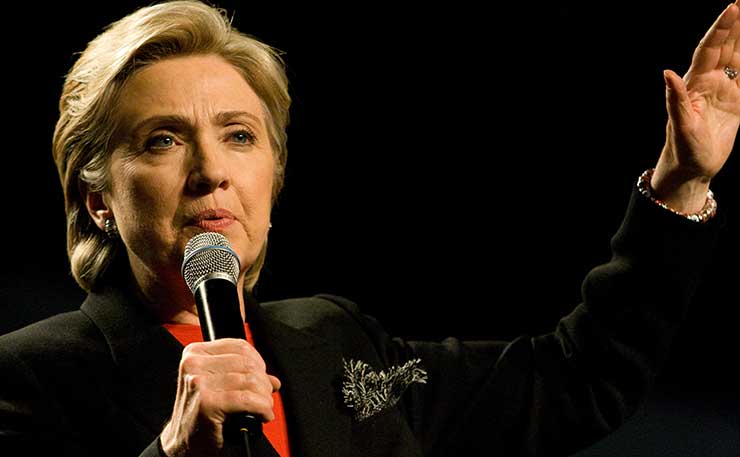
Where US pollsters fell down in 2016, and to a lesser extent again in 2020, is in the more marginal states where the battle for the White House is most hotly contested. Places like Georgia, Wisconsin, Pennsylvania, Michigan, Arizona, and to a lesser extent the bigger states like Florida and Ohio.
In particular, polling has been unreliable in rural areas and where folks without a university degree reside. It’s no coincidence that these are the very folk, on average, most likely to vote for Trump. They’re also less likely to be reached by pollsters.
It’s an ongoing problem, but that doesn’t mean the polls are useless – the good ones are still very good at predicting national trends.
By some margin, the best pollster to follow is FiveThirtyEight.com, which uses a complex system of aggregating polls from all over the US. Indeed, that’s the polling I’ve used to research this article.
Is Trump really bigger than God’s underpants?
Trump has long claimed that the polls are being manipulated to make him look bad, and that in fact he’s easily the most popular president in US history.
Of course, as with so many things ‘Trump’, the opposite of what is being claimed is often the truth. And so rather than being the most popular US president ever, Trump actually has the lowest average approval rating on record, since polling began in 1937.
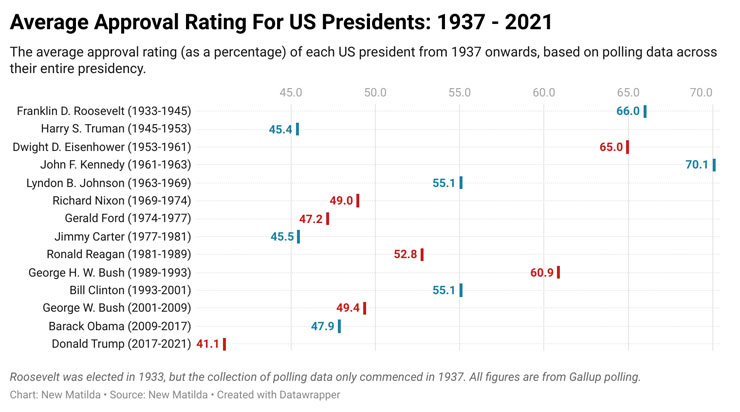
Those figures are bad enough, but they’re even worse for Trump if you look not at averages, but at the highest single result each president has ever managed to achieve – that is, what was the pinnacle of his polling?
On that front, the numbers are actually quite shocking.
Trump’s best ever ‘approval rating’ is not only the lowest on record, but during the course of his presidency, Trump never actually even cracked the 50% mark. That means that during his entire time in office, more people always disapproved of Trump’s performance than ever approved of it.
That is unprecedented. Since polls began almost 100 years ago, no president has failed to crack the 50% mark at least once.
Biden has the next ‘lowest high’, but it’s still a full eight points better than Trump (57%), and Biden managed to stay above 50% for the first seven months of his presidency.
By any reasonable measure, the figures around Trump’s actual popularity are a political train wreck.
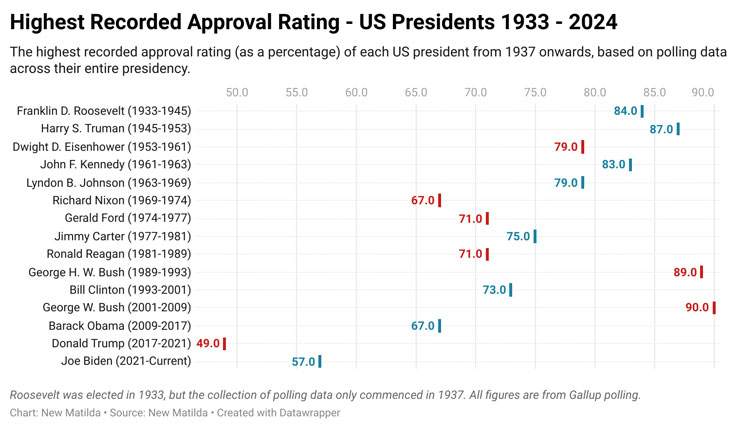
What these figures confirm is that amongst US voters, there’s very little ‘indifference’ to Trump.
The voter turnout figures also back this up – voting is not compulsory in the US, and it’s not unusual for voter turnout to be in the 50% range. But the 2020 election contested between Trump and Biden saw the largest voter turnout in more than a century, at 66.8%.
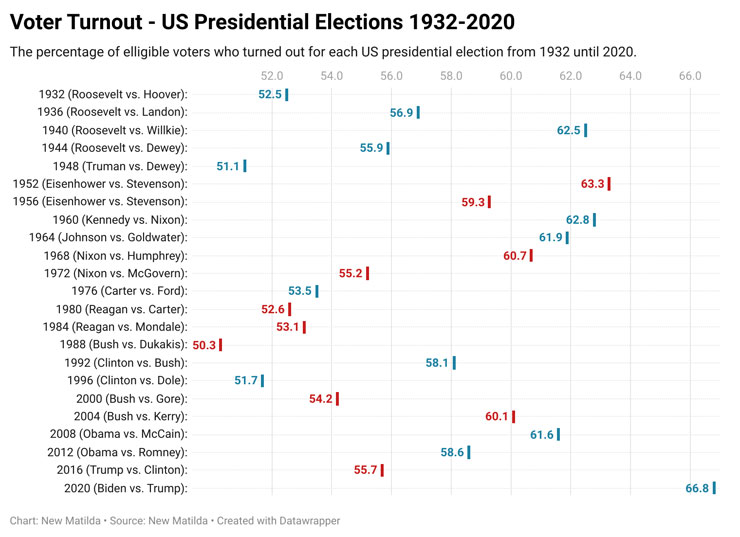
Donald breaks the mould
The last time a sitting US president was shot in an assassination attempt was in 1981.
Then, Ronald Reagan was shot by John Hinckley Jnr as he left a hotel in Washington, the bullet ricocheting off Reagan’s limousine and striking him in the chest, penetrating his lung and causing significant internal bleeding.
Reagan was just two months into his first term as president, so he was still relatively popular when he was shot. Polling on the day before the assassination attempt gave Reagan an approval rating of around 60%. One day after the shooting, a Washington Post poll saw that number jump to 73%.

While Reagan never climbed above 70% again, he consistently polled relatively well through his first term, and at his second and final election he won the most electoral college votes in history, at 525. That translated to a staggering 58.8% of the popular vote, compared to 40.6% for his opponent, Walter Mondale (the former Vice President under Carter). Indeed, Mondale managed just 13 electoral college votes, winning his home state of Minnesota, plus Washington D.C.
The moral being… generally speaking, if a US president gets shot, his re-election chances are pretty good.
Unless he’s Donald Trump. Then, it appears not to make much difference. Which seems an extraordinary thing to say in a country mired in violence. But the numbers here don’t lie.
As Americans come to terms with the second attempt on Trump’s life, the polls over the next few days and weeks are worth watching. But based on the reaction of American voters to Trump actually being wounded in July, it seems highly unlikely Trump will see any significant bounce in the polls.
Since July 24, when she formally announced her candidacy, the Democrats’ new nominee, Vice President Kamala Harris, has led Trump in the polls. On current trends, he’s going to have to do more than just get shot if he wants to beat her.
Watch this space.
Donate To New Matilda
New Matilda is a small, independent media outlet. We survive through reader contributions, and never losing a lawsuit. If you got something from this article, giving something back helps us to continue speaking truth to power. Every little bit counts.




